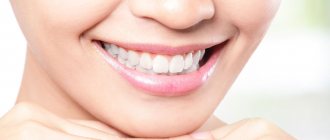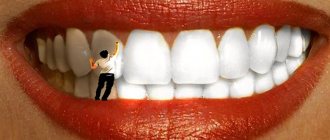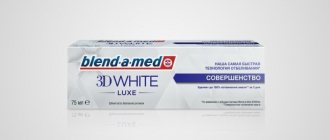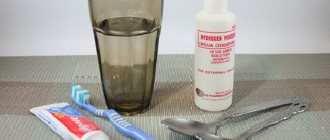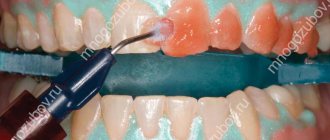Spices are not only tasty, but also beneficial for the health of your teeth and oral cavity. How were our grandmothers and great-grandmothers treated before medicine became available to the public? Before the advent of modern and generally available medicine, people were treated using the gifts of nature.
Modern medicines are undoubtedly very effective, however, we should not forget about the beneficial properties of natural remedies. Sometimes, it is possible to provide medicinal, preventive and cosmetic care for the oral cavity using the gifts of nature. This is not only cheaper, but may be healthier for the body. Natural preparations for the most part are completely safe for use by children, pregnant and breastfeeding women, and the elderly. The same cannot be said about tablets, sprays and ointments that are of factory origin. However, even when taking natural remedies, consultation with a doctor is necessary.
The effectiveness of using turmeric for teeth whitening
The main advantage of using the paste is that turmeric is safe for teeth and oral cavity due to its natural origin. It is rich in vitamin C, calcium, selenium and magnesium.
This powder does not damage the enamel surface, it removes plaque, stones, and has anti-inflammatory properties. Teeth whitening with turmeric is one of the few mild ways to implement this procedure.
You shouldn’t expect “Hollywood” white enamel from turmeric
Using any folk method, you must be clearly aware of this fact. Turmeric in this case is no exception. It will be able to lighten the enamel a little, returning it to its natural or natural shade. But even then, only if your teeth are not too neglected. If there is a large layer of plaque and hard deposits on them, and you are a coffee and cigarette lover, then the product will not be able to significantly affect the shade of the enamel - here you need the help of a qualified dentist, professional oral hygiene, and in-office whitening techniques. The product will not help improve the aesthetics of a smile even with non-carious problems, for example, with a wedge-shaped defect or enamel fluorosis.
Procedure and recipes
To achieve your goal, you need to choose one of the proposed recipes, and then clean your mouth with toothpaste. Use a medium or soft brush.
If the composition contains soda or salt, then during the cleaning process do not use excessive force so as not to damage the surface of the tooth enamel. It is better to use different toothbrushes, one for applying the whitening mixture and the other for toothpaste.
Recipe 1
A simple and easy way to lighten enamel is to dilute turmeric with water. Add liquid drop by drop until you get a smooth, thick mixture. Next, you need to dip your toothbrush in the resulting whitening agent and clean your teeth using circular movements. Keep the spice on the surface of the enamel for a maximum of 5 minutes, then rinse thoroughly with water.
It is possible to use the spice in dry form; to do this, it is necessary to clean the enamel from food particles and visible plaque. Soak a clean toothbrush in warm water, dip in the spice and begin brushing your teeth, then rinse your mouth with water. Afterwards, clean your mouth with paste.
Recipe 2
To obtain a visible effect, add lemon juice to the spice. It is able to kill germs, remove plaque and give fresh breath. Add salt to the mixture; it washes out toxins well, which negatively affect the whiteness of the enamel.
Turmeric root is better suited for this preparation. It must be dried in a well-heated frying pan, crushed to obtain a powder and used in this form for a lightening paste.
Mix all the ingredients of the recipe - turmeric root powder, salt, lemon juice. You can use the resulting mixture to clean the enamel or apply it to your teeth and leave for a few minutes. Then rinse your mouth thoroughly with cool water and clean with regular toothpaste.
Recipe 3 (with coconut oil)
Another effective way to lighten teeth is to use a thick consistency product consisting of yellow spice and coconut oil. To prepare it you will need:
The oil must be heated in a water bath until it becomes liquid, then add dry turmeric powder to it. Apply the resulting mixture to the enamel and leave for a few minutes, then rinse the mouth thoroughly with water.
Do not use turmeric before going to the dentist
This should not be done if surgical intervention is planned - tooth extraction or implantation. This product has long been famous for its ability to thin the blood, so it will harm those with poor blood clotting. During the treatment process, any impact on the gums and soft tissues can complicate the doctor's work.
Notice
: Undefined variable: post_id in
/home/c/ch75405/public_html/wp-content/themes/UltraSmile/single-item.php
on line
45 Notice
: Undefined variable: full in
/home/c/ch75405/public_html/wp-content /themes/UltraSmile/single-item.php
on line
46
Rate this article:
( 3 ratings, average: 5.00 out of 5)
whitening
- Zafir A, Banu N. Antioxidant potential of fluoxetine in comparison to Curcuma longa in restraint-stressed rats. Eur J Pharmacol. 2007;572(1):23-31
Consulting specialist
Kashaeva Victoria Nikolaevna
Specialization: Dental hygienist Experience: 7 years
Features and duration of the whitening course
To get good results, you can use the whitening paste 3-4 times a week. Once your goal is achieved, you can maintain white teeth by using the powder once a week. To strengthen the whiteness, you can prepare a turmeric-based mouthwash; rinse your mouth with this mixture daily.
To maintain the results obtained as long as possible, you need to drink a lot of water, exclude coffee, strong tea, alcohol, beets, carrots, tomato and soy sauces, carbonated drinks with bright dyes, berries and fruits with coloring pigments (mulberries, cherries) from your diet. It is necessary to quit smoking if possible.
It is important to remember that using whitening paste too often can lead to thinning of the enamel and tooth sensitivity.
Turmeric for teeth whitening may not be suitable for everyone. To ensure that the procedure does not harm the body, you need to carefully monitor its reaction to the use of natural lightening agents. If you feel itching or burning during the process, you should immediately rinse your mouth with water. Unpleasant sensations may arise due to damage to the enamel and individual intolerance to the components of the paste.
Turmeric can be replaced with curry
The homeland of natural turmeric is India. There, the root or powder of this variety of plant from the ginger family has been used for more than 2.5 thousand years. The main areas of use are cooking and Ayurveda medicine. Also, turmeric is always included in spices such as curry. That is why you can use curry instead of turmeric to whiten teeth, but only if you are sure that the spice contains a natural product and not a substitute. Unfortunately, in Russia this situation occurs quite often.
Turmeric can be replaced with curry
How can you check the naturalness of a product? When rubbed on your fingers, fresh turmeric will release a very bright spicy aroma, and if the smell is very weak or absent, then this composition is unlikely to bring tangible benefits.
Possible contraindications
Before using whitening spice paste, you need to familiarize yourself with a number of contraindications:
- do not use bleaching powder if you have kidney stones, ulcers, or problems with the ducts or gall bladder;
- when taking strong medications, it is better to postpone whitening using spices until the end of the course of taking pills;
- pregnancy and breastfeeding are also contraindications;
- possible decrease in testosterone levels in men;
- increased sensitivity and damage to enamel.
Nutmeg
Nutmeg - thanks to its antibacterial properties, successfully copes with halitosis and other causes of bad breath. That is why nutmeg is often included in the composition of toothpaste. The beneficial properties of nutmeg also extend to gum disease and toothache.
Beneficial features:
- Removes plaque;
- Fights bad breath;
- Relieves swelling and helps block the inflammatory process.
Application method:
- Nutmeg infusion;
- Rub the spice oil into the affected areas.
Reviews
Veronica, 21 years old: “I thought that using the spice would make my teeth even more yellow, since I used spices to tint dishes, but the result was surprising. Contrary to my fears, turmeric was also suitable for teeth. They became lighter after just a week of cleaning with paste and powder. And if you add lemon juice, the effect will be much better.”
Egor, 34 years old: “To whiten enamel, I used to use a combination of hydrogen peroxide and salt. But this remedy did not work because it turned out to be too strong. The enamel began to deteriorate, the teeth became more sensitive. Turmeric worked much better for whitening because it is much gentler. Now I use only this method and am pleased with the result.”
Olga, 27 years old: “I tried many methods of teeth whitening, but nothing really helped. But, after looking at articles and reviews, I saw a method using turmeric and coconut oil to whiten teeth. I tested it and saw for myself that the recipe works. No, your teeth will not turn yellow, but you must use the powder carefully. Upon completion of the procedure, you just need to thoroughly clean your teeth with the paste, making sure that the yellow spice does not remain on your teeth and gums. The product must be used regularly to maintain the results.”
Ekaterina, 37 years old: “Before using the new method, there was a fear that the teeth would turn yellow, but this did not happen; on the contrary, the enamel became whiter than it was before. There is a visible result, but with the addition of coconut and mint oil, I liked the effect better. After an interesting experiment, I recommend this recipe to my friends. Most are satisfied."
Maxim, 29 years old: “After reading about the method of lightening tooth enamel using turmeric, I was surprised, but then I decided to try the recipe on myself. The result met my expectations, and to consolidate the whiteness effect, every other day I rinse my mouth with a solution with this interesting spice. And after eating, I cut a thin circle from the turmeric root and chew it for 3-5 minutes. This removes fresh plaque well.”
Turmeric is a surprisingly effective teeth whitener. Here's how to whiten your teeth naturally, without chemicals. They say a smile is the most beautiful thing you can “wear.”
I say that considering some of the questionable fashion choices I've made since becoming a mom.
Many nations spend over a billion dollars a year on over-the-counter teeth whitening products, often without realizing the risks. Luckily, we don't need them—we can just head to the pantry and most likely find at least one ingredient that naturally whitens.
This is not only a safer option, but also more affordable.
Teeth whitening practical results
You may notice an immediate difference the first time you use turmeric for teeth whitening. But if you do this consistently for a few days to a week, I think you'll be surprised how significant it is. Hey, before you know it, you'll probably be telling your best friend, sister, or mom to use turmeric to whiten your teeth too!
Will your teeth be so dazzlingly white that they look like they glow in the dark? No. Many of us are used to seeing ultra-white Hollywood smiles, but what is rarely mentioned is that these smiles are often achieved by placing veneers on the front of natural teeth. It's simply not possible to whiten your teeth that white, but it's not necessary for a great, healthy smile.
I mean, according to Mother Nature Network, “Former Miss USA Susie Castillo swears by her homemade toothpaste recipe that includes turmeric powder.
Now we'll get to today's technique in a second, but first let me tell you...
Comments
I am now two months pregnant, can I try brushing my teeth with turmeric, will it cause any harm?
Tatyana (03/31/2019 at 12:25) Reply to comment
- Dear Tatyana! It is not advisable to use turmeric for women who are pregnant or breastfeeding. In particular, this restriction applies to those who use it internally for medicinal purposes, but when cleaning your teeth, the product can enter the stomach through the mouth or you can swallow a little of the composition - this is not dangerous, but it is worth remembering that turmeric can cause uterine contractions, as well as provoke the development of allergies and diathesis in the child.
Editorial staff of the portal UltraSmile.ru (04/04/2019 at 09:07) Reply to comment
Good afternoon. If you have several metal-ceramic crowns on your front teeth, you can whiten your living teeth with turmeric. Will turmeric stain metal-ceramic crowns? After all, it is written that it leaves stains even on the sink, etc.
Marina (05/18/2019 at 00:30) Reply to comment
Write your comment Cancel reply
Why I Ditched Teeth Whitening Strips
A few years ago, I was so addicted to whitening strips that I would often insert strip after strip after lunch. I didn't know that you should use over-the-counter strips a maximum of twice a year, and that increasing the frequency carries risks to your dental health.
My teeth started to hurt and the ends became slightly translucent, which is a reported side effect of regular teeth whiteners. "The media has done a good job of making whitening sound harmless, but it's not," Dr. Ira Handschuh, a dentist in White Plains, NY, told ABC News.
According to the article, "Carbamide peroxide, the bleaching agent in most whiteners, can irritate gums, causing them to recede, leaving teeth brittle, chalky, and so thin that they become translucent at the edges with overuse of the product."
What upset me even more was that my teeth turned yellow again and again after each treatment, so the more often I used them, the less effective they were.
Of course, these are just some of the problems associated with conventional whitening procedures. Long-term effects are not fully known, but one older study suggests there may be a link between oral cancer in young people and the use of teeth whitening products.
The study was very small and is not conclusive by any means, but a subsequent study of dentist-administered whitening procedures (which use the same basic chemicals, just in higher concentrations) also found potential genotoxic effects.
So how did I break the habit? Well, around the time I developed tooth sensitivity, I discovered real food, ditched the strips, embraced bone broth, and started making my own deodorant and tooth foam.
My health began to improve, my teeth became opaque again, and the rest, as they say, is history.
Turmeric Teeth Whitening Method
1. Wet your toothbrush and then dip it into 1/8 teaspoon of turmeric powder. Brush your teeth as usual, but instead of rinsing, when you're done, let the turmeric sit on your teeth for 3-5 minutes so it can work its magic.
2. Spit out and rinse your mouth thoroughly, then repeat brushing using regular tooth powder/toothpaste. If you notice yellow around the corners of your mouth, rinse it with mouthwash and it will come off. Likewise, leaving turmeric powder on your teeth or gums will result in a slight yellowish tint, but once the turmeric is completely washed away, you should notice a brighter, whiter smile. I personally find this homemade toothpaste to be the most effective turmeric remover, so you can see the results underneath.
You may notice a difference with the first statement. If not, give it a few days a week - if you're skeptical, I think you'll be pleasantly surprised!
Turmeric will help keep your gums healthy
Turmeric is not only good for your teeth as a homemade whitening agent, but it is also good for preventing gum disease. The beneficial substances included in its composition (in particular, curcumin and essential oil) have anti-inflammatory, wound-healing, antiviral, and disinfectant effects. It increases blood circulation, regulates metabolism and improves local immunity. It is a kind of natural antibiotic and antioxidant1. Therefore, when using this product, you immediately “kill two birds with one stone”: you make your teeth whiter and your gums healthier. But there must be moderation in everything; you cannot use turmeric on a regular basis; it is enough to brush your teeth with it no more than 2-3 times a week.
The product helps to take care not only of teeth, but also of gums
How to whiten teeth with turmeric? Feedback from Internet users suggests that the most effective and safest way is to use the product instead of regular toothpaste. To do this, just add a few drops of water to ¼ teaspoon of powder, achieve the consistency of a thick cream and apply the resulting composition to the brush. It is advisable to use a separate toothbrush for these purposes, because... a natural product will still lead to permanent coloring.
“I use turmeric not only for teeth! The same paste, diluted with water to the consistency of thick sour cream, can work wonders on the skin. It helps me well with eczema, helps get rid of blackheads on my face and acne. I also tried to use it for cosmetic purposes, applying it to the face in the form of a mask - after this the skin becomes soft and smooth, toned, pink. Overall, the lifting effect is remarkable. And her grandmother recently gave her a boil. But all this can be done if you do not have intolerance to the product or hypersensitivity to it.”
Tara, review from otzovik.com
Step by Step Guide to Teeth Whitening with Turmeric
1. Dip your toothbrush into the toothpaste and brush your teeth as usual, but instead of rinsing, when you're done, let the toothpaste sit on your teeth for 3-5 minutes so it can work its magic.
2. Spit out and rinse your mouth thoroughly, then repeat brushing using regular tooth powder/toothpaste. If you notice yellow around the corners of your mouth, wash it with soap and it will wash away. Likewise, leaving turmeric powder on your teeth or gums will result in a slight yellowish tint, but once the turmeric is completely washed away, you should notice a brighter, whiter smile.
I personally find this homemade toothpaste to be the most effective turmeric remover so you can see results after using it. You may notice a difference with the first use. If not, give it a few days a week - if you're skeptical, I think you'll be pleasantly surprised!
Thyme - Thyme
Thyme (thyme) - contains tannins, mineral salts, essential oil, flavonoids, malic, ursolic, oleanolic acids. Thyme essential oil contains thymol, which is included in the best toothpastes and elixirs, which have a strong bactericidal effect and prevent dental caries. Thyme has disinfecting properties, fights pathogenic microflora of the mouth, and its ability to relieve inflammation is used in the treatment of gums, such as gingivitis or periodontitis.
Beneficial features:
- Painkiller;
- Disinfectant;
- Anti-inflammatory.
Application method:
- Rinse with infusion.
